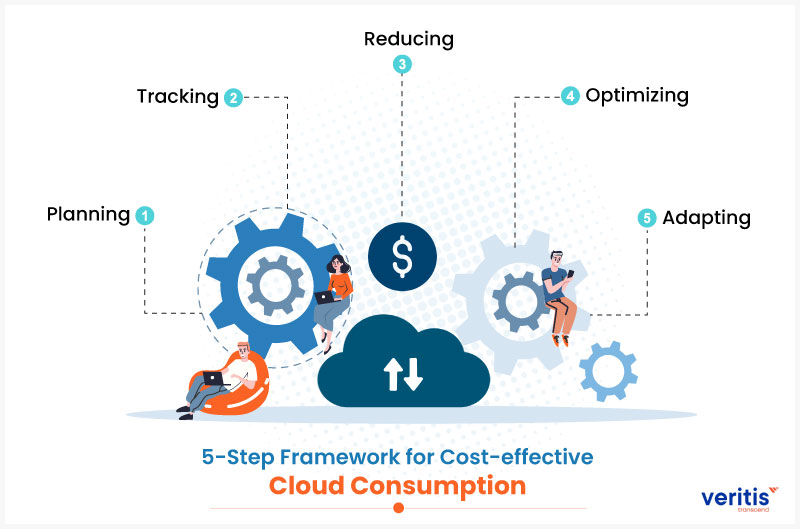
Cloud adoption has taken a quantum leap during the pandemic. Companies worldwide have accelerated their cloud migration journey to sustain their businesses. However, the speed and scale at which businesses embraced the cloud, often without proper or any diligence, has introduced several new challenges. And managing cloud spending is proving to be one of the most difficult.
While leveraging cloud resources, enterprises are charged whenever consumption occurs. This contrasts with the once-off payment when they invest in data centers. In cloud computing, organizations often face challenges in hammering accurate cost estimates.
They struggle to explain the bills and define items responsible for spending. Consequently, financial management takes the backseat until spending goes out of control.
Also Read: US Public Cloud Services Market: USD 2.5 ROI on Every Dollar!
Instead of waiting for the guillotine to drop, let’s have a look at the factors that shroud public cloud cost management:
- Pricing complexity: Cloud pricing and billing structures have innumerable permutations and combinations. One ought to spend significant time duly understanding these structures and choosing the best pricing model which suits their needs.
- Inexhaustive bill items: Cloud bills often come with thousands of line items, even for normal consumption. This aspect complicates cost attribution, which is crucial for initiating the chargeback.
- Self-service provisioning: The easy provisioning of cloud services through a self-service portal often leads to ‘resource sprawling,’ which, in turn, results in unexpected charges. Cloud resource sprawl occurs when organization fails to decommission unsured cloud instances or services.
- Evolving cloud offerings: Cloud vendors constantly refine their offerings with new features, instance types, and pricing models. It is quite arduous for organizations to catch up with this pace of change and take heed of the financial alterations that follow.
- Lack of standardized billing models: Cloud vendors do not offer any standardized bills as each one has their own set of pricing models and formats. These variations unwittingly make it difficult for organizations to manage costs.
The listed challenges underscore how organizations ought to develop a strategic financial management plan to ax overspending and unlock new saving opportunities. The rest of the blog shall guide you through a 5-step framework to manage the costs of public clouds. Let’s delve into it:
5-Step Framework for Cost-effective Cloud Consumption

Cloud cost management is a herculean task. It starts with organizations estimating their cloud consumption and defining budget expectations. Then, they must track what cloud resources are being utilized for each project or application. This helps organizations optimize their cloud spending by trimming their unwanted resources.
Also Read: Public Cloud, Key Contributor to Cloud Security Market 2018-23
This cloud management framework highlights a series of capabilities that organizations must imbibe to budget, track, and optimize cloud spending. This framework applies to every organization, regardless of cloud maturity. Moreover, the framework applies to all major cloud vendors, including AWS, Azure, and Google Cloud.
Organizations must develop capabilities in the following five distinct areas:

1) Planning
The first step towards cost-effective cloud consumption is developing capabilities to set budgets and forecast consumption as accurately as possible. This enables you to forge a baseline against which actual consumption can be measured.
This stage involves defining the requirements, drafting system architectures, choosing pricing models, forecasting consumption, and establishing a budget. Finally, one ought to deploy a pilot of their application before deploying it in production to detect misconfigurations early and improve their forecast accuracy.
2) Tracking
Once the budget is set and the application is deployed, organizations must gain clear visibility into cloud spending. This empowers you to assess whether the deployed resources add value and whether they are required.
This stage involves designing a native hierarchy, allocating costs of shared resources, defining tracking metrics, detecting flaws, and initiating the chargeback.
3) Reducing
One must connect the dots to reduce the bill with deep insights into spending metrics. Start with disposing of unused resources. This is one area a client must focus on as one tends to buy a lot of unwanted features unknowingly when they subscribe to a package. After trimming the unused resources, align the service’s footprint with actual demand and utilize the available discount models.
4) Optimizing
Cloud cost optimization techniques call for application architectural changes to minimize resource needs. For instance, developing a cloud-native application helps realize more ROI than traditional apps. Some best practices to optimize cloud bill includes using preemptible instances, implementing horizontal autoscaling, leveraging serverless tech, and modernizing apps for PaaS.
5) Adapting
With the IT world changing constantly, one must adapt to the changes to stay ahead of the curve. Organizations ought to deploy the right set of automation tools for financial and data management. Onboard multiple cloud vendors for optimal workload placement, which helps drive cost optimization. Then, identify business KPIs which can correlate with your cloud costs to measure ROI in cloud computing.
Also Read: Catalyzed by COVID, Public Cloud Spending to Reach USD 692 Bn by 2025!
Final Thoughts

Though these five areas are mentioned sequentially, it is not mandated to implement them in the same order. Organizations can follow an iterative approach and develop each capability independently.
Although these capabilities have inter-dependencies, they shouldn’t impede the development of subsequent capabilities. For instance, one can focus on cutting costs even if they don’t track their spending precisely.
However, one must take due diligence in following this structured framework to achieve operational excellence in managing public cloud spending. Ignoring even the minute aspects may cost you dearly. This is where Managed Cloud Service Providers like Veritis excel.
We, at Veritis bring in deep industry and domain knowledge to engineer and apply the potential of cloud technologies to your business. With over a decade-long proven experience in catering to the needs of multifarious clients, including Fortune 500 firms, we help you harness innovation to drive efficiency and unlock value. Reach out to us to leverage our end-to-end set of integrated cloud offerings and solutions.
More Articles:
